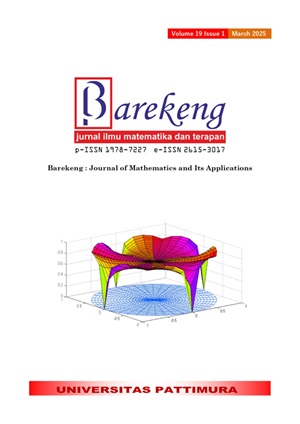UNDERSTANDING LQ45 STOCKS (2021-2023) WITH K-MEANS CLUSTERING
Abstract
The primary aim of this study is to examine the use of K-Means clustering in analyzing LQ45 stocks from 2021 to 2023, utilizing data obtained from the Yahoo Finance platform. The analysis delves into key performance measures such as the price-to-earnings ratio (PER), earnings per share (EPS), dividends, trading volume, and historical return on investment. This technique categorizes stocks with similar characteristics, providing financial analysts, money managers, and investors with valuable insights. The objective of the clustering analysis is to gain a deeper understanding of the relationship between intrinsic stock features and the inherent price volatility of companies. This is accomplished by using historical datasets to conduct stock feature analysis. Mathematics plays a crucial role in the K-Means model by providing the foundational algorithms and statistical methods used to categorize and analyze the data. The study contributes to the field of financial market analysis by demonstrating how understanding group-to-group dynamics can affect investment decisions and offering a more precise representation of large datasets in financial contexts. These findings provide significant insights for individuals involved in financial matters in the stock market, helping to identify potential investment opportunities and reduce risk more effectively.
Downloads
References
I. Sudarman and N. Diana, “The Effect of Financial Ratios on Sharia Stock Prices in Companies in the LQ45 Index 2020-2021,” Jurnal Ilmiah Ekonomi Islam, vol. 8, no. 1, p. 117, Feb. 2022, doi: 10.29040/jiei.v8i1.4228.
J. Saputri, D. Oktafalia, and M. Muzammil, “Analisis Return Portofolio yang Optimal Pada Saham LQ 45 yang Tercatat di Bursa Efek Indonesia Selama Periode,” Business & Management Journal Bunda Mulia, vol. 8, no. 1, 2008.
B. Supeno, “Competitive Environment Analysis Through Finance Fundamentals Analysis: LQ45 stock prices on the Indonesia stock exchange,” IOP Conf Ser Earth Environ Sci, vol. 469, no. 1, p. 012074, Apr. 2020, doi: 10.1088/1755-1315/469/1/012074.
J. Rowena, “Earnings Volatility, Kebijakan Dividen, Dan Pertumbuhan Asset Berpengaruh Terhadap Volatilitas Harga Saham Pada Perusahaan Manufaktur Di BEI Periode,” Jurnal Administrasi Kantor, vol. 5, no. 2, pp. 231–242, 2017.
D. Wu, X. Wang, and S. Wu, “Construction of stock portfolios based on k-means clustering of continuous trend features,” Knowl Based Syst, vol. 252, p. 109358, Sep. 2022, doi: 10.1016/j.knosys.2022.109358.
Z. Fang and C. Chiao, “Research on prediction and recommendation of financial stocks based on K-means clustering algorithm optimization,” Journal of Computational Methods in Sciences and Engineering, vol. 21, no. 5, pp. 1081–1089, Nov. 2021, doi: 10.3233/JCM-204716.
B. B. Nair, P. K. S. Kumar, N. R. Sakthivel, and U. Vipin, “Clustering stock price time series data to generate stock trading recommendations: An empirical study,” Expert Syst Appl, vol. 70, pp. 20–36, Mar. 2017, doi: 10.1016/j.eswa.2016.11.002.
T. M. Ghazal et al., “Performances of K-Means Clustering Algorithm with Different Distance Metrics,” Intelligent Automation & Soft Computing, vol. 29, no. 3, pp. 735–742, 2021, doi: 10.32604/iasc.2021.019067.
M.-S. Yang and K. P. Sinaga, “A Feature-Reduction Multi-View k-Means Clustering Algorithm,” IEEE Access, vol. 7, pp. 114472–114486, 2019, doi: 10.1109/ACCESS.2019.2934179.
P. Govender and V. Sivakumar, “Application of k-means and hierarchical clustering techniques for analysis of air pollution: A review (1980–2019),” Atmos Pollut Res, vol. 11, no. 1, pp. 40–56, Jan. 2020, doi: 10.1016/j.apr.2019.09.009.
K. A. Sidarto, M. Syamsuddin, and N. Sumarti, Matematika Keuangan, 1st ed. Bandung: ITB Press, 2019.
V. Veny and Y. Gunawan, “Perubahan Harga Saham Dilihat dari Faktor Fundamental Perusahaan Makanan dan Minuman,” Jurnal Akuntansi Bisnis, vol. 15, no. 1, Feb. 2022, doi: 10.30813/jab.v15i1.2874.
J. H. Wijaya and K. Gusni, “The Influence of Financial Performance against Stock Prices in Companies Listed in LQ45 Index 2012-2016 Period,” 2018. [Online]. Available: www.sciencepubco.com/index.php/IJET
A. C. H. Choong and N. K. Lee, “Evaluation of convolutionary neural networks modeling of DNA sequences using ordinal versus one-hot encoding method,” in 2017 International Conference on Computer and Drone Applications (IConDA), IEEE, Nov. 2017, pp. 60–65. doi: 10.1109/ICONDA.2017.8270400.
M. K. Dahouda and I. Joe, “A Deep-Learned Embedding Technique for Categorical Features Encoding,” IEEE Access, vol. 9, pp. 114381–114391, 2021, doi: 10.1109/ACCESS.2021.3104357.
V. Sharma, “A Study on Data Scaling Methods for Machine Learning,” International Journal for Global Academic & Scientific Research, vol. 1, no. 1, Feb. 2022, doi: 10.55938/ijgasr.v1i1.4.
M. Ahsan, M. Mahmud, P. Saha, K. Gupta, and Z. Siddique, “Effect of Data Scaling Methods on Machine Learning Algorithms and Model Performance,” Technologies (Basel), vol. 9, no. 3, p. 52, Jul. 2021, doi: 10.3390/technologies9030052.
D. Marutho, S. Hendra Handaka, E. Wijaya, and Muljono, “The Determination of Cluster Number at k-Mean Using Elbow Method and Purity Evaluation on Headline News,” in 2018 International Seminar on Application for Technology of Information and Communication, IEEE, Sep. 2018, pp. 533–538. doi: 10.1109/ISEMANTIC.2018.8549751.
A. Sofia, “K-MEANS CLUSTERING USING ELBOW METHOD IN CASE OF DIABETES MILLETUS TYPE II IN INDONESIA,” Journal of Statistical Methods and Data Science, vol. 1, no. 2, Apr. 2024, doi: 10.31258/jsmds.v1i2.5.
M. A. Syakur, B. K. Khotimah, E. M. S. Rochman, and B. D. Satoto, “Integration K-Means Clustering Method and Elbow Method For Identification of The Best Customer Profile Cluster,” IOP Conf Ser Mater Sci Eng, vol. 336, p. 012017, Apr. 2018, doi: 10.1088/1757-899X/336/1/012017.
Copyright (c) 2025 Margareta Febe, Giovanny Theotista, Winson Winson

This work is licensed under a Creative Commons Attribution-ShareAlike 4.0 International License.
Authors who publish with this Journal agree to the following terms:
- Author retain copyright and grant the journal right of first publication with the work simultaneously licensed under a creative commons attribution license that allow others to share the work within an acknowledgement of the work’s authorship and initial publication of this journal.
- Authors are able to enter into separate, additional contractual arrangement for the non-exclusive distribution of the journal’s published version of the work (e.g. acknowledgement of its initial publication in this journal).
- Authors are permitted and encouraged to post their work online (e.g. in institutional repositories or on their websites) prior to and during the submission process, as it can lead to productive exchanges, as well as earlier and greater citation of published works.






1.gif)



